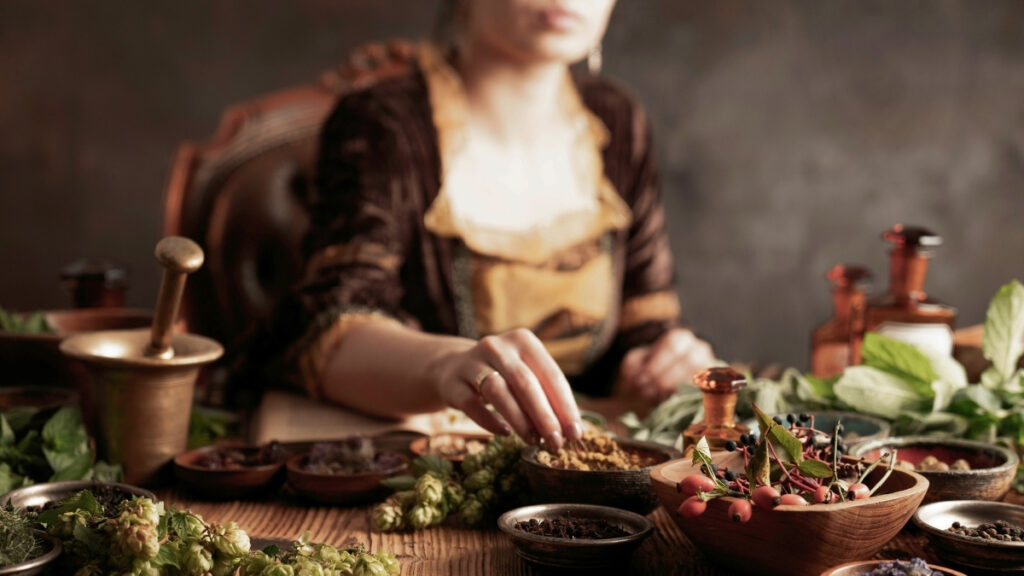
As Halloween approaches, the allure of witches and their potions resurfaces, often linked to eerie botanicals like belladonna, mandrake, and mugwort. While these plants are steeped in myth and folklore, their historical and medical significance is equally captivating. Behind the stories of spells and sorcery lies a trove of pharmacological insights that continue to influence modern medicine.
Belladonna: Beauty and Danger
Belladonna (Atropa belladonna), commonly known as deadly nightshade, has a complex legacy as both a poison and a medicine. Its name translates to “beautiful woman” in Italian, reflecting its historical use as a cosmetic to dilate pupils for enhanced allure during the Renaissance. Despite its beauty, belladonna is highly toxic; ingesting just a few berries or leaves can be fatal.
The plant’s potency comes from tropane alkaloids such as atropine and scopolamine, which block acetylcholine, a neurotransmitter crucial for various bodily functions including heart rate and digestion. In modern medicine, atropine is utilized to dilate pupils during eye examinations, treat bradycardia (slow heart rate), and serve as an antidote for certain types of poisoning. Scopolamine is frequently prescribed for motion sickness and postoperative nausea.
Despite its benefits, safety concerns linger. Multiple healthcare agencies have warned against homeopathic products containing belladonna, particularly those marketed for infants to alleviate teething and colic, due to reports of serious side effects such as seizures and respiratory issues. Caution is also advised for individuals taking medications that may interact negatively with belladonna.
Mandrake: Myth and Medicine
Another notable member of the nightshade family is mandrake (Mandragora officinarum). Its root, resembling a human shape, has inspired legends from ancient Greece to biblical texts. Folklore suggests that uprooting a mandrake will produce a deadly scream, a tale echoed in contemporary literature, including the Harry Potter series.
In historical contexts, mandrake was believed to possess magical properties, often included in love potions and flying ointments. It was historically used as an anesthetic and sedative. Like belladonna, mandrake contains tropane alkaloids, which contribute to its psychoactive effects. A 2022 study identified 88 traditional medicinal uses for mandrake, ranging from pain relief to treating digestive disorders.
While scopolamine can alleviate muscle spasms in the gut, the efficacy of mandrake extracts remains contentious, with some research suggesting they may cause skin irritations rather than treat them effectively.
Mugwort: From Folklore to Modern Medicine
Mugwort (Artemisia species) is another herb entwined with magic and health. Traditionally, it has been used to enhance dreams and ward off evil spirits. In 2015, a Nobel Prize was awarded for the discovery of artemisinin, an anti-malarial compound derived from Artemisia annua, or annual mugwort.
In traditional Chinese medicine, mugwort plays a role in moxibustion, a therapy involving the burning of the herb near acupuncture points to promote healing. Herbalists often use it to address menstrual irregularities and digestive issues. Common mugwort is recognized in the European Pharmacopoeia for its applications in treating conditions such as menopause symptoms and anxiety.
The above-ground parts of mugwort yield essential oil containing compounds like camphor and cineole, known for their antioxidant and antimicrobial properties. Animal studies indicate that Artemisia leaf extract could alleviate inflammatory skin conditions by mitigating inflammation-causing chemicals, though clinical evidence is still limited. As with the other plants, mugwort may trigger allergic reactions and should be avoided during pregnancy due to potential risks.
The narratives surrounding these plants might seem steeped in fantasy, yet their real impact on health and medicine is undeniable. As researchers continue to investigate their properties, it becomes clear that the stories of belladonna, mandrake, and mugwort are deeply rooted in both folklore and science.
As we celebrate Halloween, it’s worth reflecting on how these herbs highlight the intersection of ancient practices and contemporary pharmacology. The true essence of these so-called potions lies not in superstition, but in the chemistry that has shaped healing through the ages.
Dipa Kamdar, Senior Lecturer in Pharmacy Practice at Kingston University, emphasizes the ongoing significance of these plants in both historical and modern contexts.






